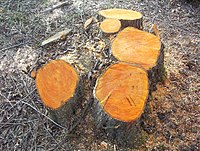
Photo from wikipedia
Short-rotation coppice willows, which are commonly propagated with cuttings, are promising bioenergy resource crops. In this study, a field trial with a completely randomized block design was carried out with… Click to show full abstract
Short-rotation coppice willows, which are commonly propagated with cuttings, are promising bioenergy resource crops. In this study, a field trial with a completely randomized block design was carried out with 787 clones from three full-sib pedigrees involving two shrub willow species. A total of 7083 cuttings were planted in the field, and the mass of each cutting was recorded correspondingly. The mortality rate, growth traits, and wood property traits of each cutting-propagated plant were measured throughout a complete growing season. The obtained data showed that heavier cuttings produced shoots with lower mortality rate, higher height, thicker ground diameter, and larger biomass production than lighter cuttings. The cutting mass significantly improved plant performance, especially at the early developmental stages. However, the cutting mass had no effect on the basic density and the main chemical composition (i.e., cellulose, hemicellulose, and lignin) of willow wood. This study provided essential information for improving the establishment of short-rotation coppice willow plantations.
Journal Title: Canadian Journal of Forest Research
Year Published: 2020
Link to full text (if available)
Share on Social Media: Sign Up to like & get
recommendations!